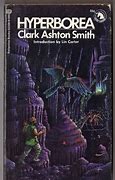In the same decades that Clark Ashton Smith wrote several stories about a magical-fantasy realm of the far future in ZOTHIQUE, he also wrote other tales about a realm ostensibly in some ahistorical version of Earth's past, HYPERBOREA. Both collections were set in an approximate historical order by editor Lin Carter and published as part of the Ballantine Adult Fantasy series.
Though I didn't see much point to establishing a continuity in the ZOTHIQUE tales, Smith did work one historical event into a few of the HYPERBOREA stories. To wit, in the best of the stories, a spectral entity called The White Sibyl prophecies that a particular kingdom will be overwhelmed by an ice-floe-- and some stories post-date the fulfillment of that prophecy. That said, on the whole the Hyperborea stories don't manage to tap into the same mythopoeic depths as the Zothique stories. However, in the Hyperborean tales Smith concocted a deity named Tsathoggua, and H.P. Lovecraft paid Smith a literary compliment by incorporating the creature into the Lovecraft bestiary of unearthly beings. As before, I'll rate each story in terms of mythicity, with G for good, F for fair, and P for poor.
THE SEVEN GEASES (G) -- This is an ironic fable akin to "The Voyage of King Euvoran" in the ZOTHIQUE collection, in that both deal with ignorant noblemen who get caught up in magical matters beyond their ken. While hunting in the mountains, the lordling Ralibar Vooz trespasses on a magician's ritual. The magician, instead of just killing Ralibar, sends him to another mage to see if the latter can make any use of the nobleman. But the second mage can't use Ralibar either, so he sends him on the toad-god Tsathoggua-- and this is repeated over and over, driving home the point that Ralibar is utterly useless to any of these cosmic entities. But in the end, even being useless doesn't save the lord from his doom.
THE WEIRD OF AVOOSL WUTHOQUAN (P) -- The fellow with the unpronouceable name is a treasure-hoarder whose fanatical greed leads him into the belly of a beast.
THE WHITE SYBIL (G) -- The poet Tortha beholds a mysterious woman in his native city, and becomes aware that she's the legendary White Sibyl, who will prophecy the city's doom by ice. Besotted with the phantom, he follows her to her chilly mountain home. For once the foolish hero manages to survive his brush with the supernatural, though at the cost of some of his faculties.
THE TESTAMENT OF ATHAMMAUS (F) -- The character in the title is the head executioner of his city, but he encounters a vexing mystery when one murderous criminal keeps coming back to life after his executions.
THE COMING OF THE WHITE WORM (F) -- Hyperborea's Ice Age results not from inert ice-floes, but from an iceberg under the command of the worm-monster Rlim Shaikorth. A wizard survives the destruction of his city only by agreeing to serve the monster, but he has to reconsider his plans when the "service" involves being the creature's food supply.
UBBO-SATHLA (P) -- This is the only story in the collection which is not a magical fantasy tale, because its main character is a denizen of the 20th century. Paul Tregardis encounters a relic from Hyperborean times, and the relic causes his personality to fuse with that of the relic's original wizard-owner. Neither entity wins the struggle as both are absorbed into the "formless mass that was Ubbo-Sathla."
THE DOOR TO SATURN (F)-- The odd inclusion of a real-world place-reference does not break with the dominant magical fantasy continuum. Two Hyperborean priests quarrel over whose god is better, but Eibon-- no doubt the author of Smith's arcane sorcery-tome, the Book of Eibon-- decides to step through a door that takes him into another world. Eibon's enemy Morghi goes through the door as well, but as a result both men are cut off from returning to Hyperborea and must work together to survive in a wholly alien world. Interestingly, Smith gives Eibon's deity the name of "Zothaqquah," suggesting that this may be a later corruption of "Tsathoggua." And though Smith may or may not have realized it, the distorted god-name also sounds a lot like-- "Zothique," which name Smith borrowed from the old Greek term "Sothic."
THE ICE-DEMON (P)-- It's another treasure-hunt story where the seekers pay the ultimate price for their greed, but it's depressingly overlong once one realizes where it's going.
THE TALE OF SATAMPTRA ZEROS (F)-- The titular character, a master thief, commits to his diary the story of what happened when he and his only rival in thievery sought to plunder the temple of Tsathoggua.
THE THEFT OF THIRTY-NINE GIRDLES (F)-- In the second and last story from master burglar Satamptra Zeros-- one of a very small number of repeating Smith characters-- the aging thief relates another one of his adventures, this time with a female accomplice-- one of the few females-with-agency in the Smith cosmos. Not bad, but it's a decided disappointment that none of the girdles are being stolen off the bodies of their feminine owners.
Carter also adds four very short non-Hyperborea tales, which are close to being "prose poems" more than short stories. Though THE ABOMINATIONS OF YONDO has the best title, it doesn't manage to conjure forth any distinct myths, nor do two of the others. But THE PASSING OF APHRODITE-- the only tale in this volume that places a historically known deity within some sketchy fantasy-world called "Illarion"-- succeeds in putting across a good, if brief, myth-vibe, as a poet mourns for the passing of the Goddess of Love and Life.

No comments:
Post a Comment